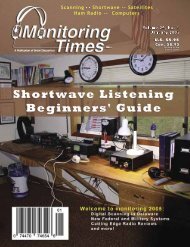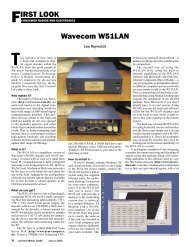RIGHT-click here - Monitoring Times
RIGHT-click here - Monitoring Times
RIGHT-click here - Monitoring Times
Create successful ePaper yourself
Turn your PDF publications into a flip-book with our unique Google optimized e-Paper software.
every week and they had teams back in Miami<br />
supporting them. When the first team arrived<br />
they realized that the head doctor was trying<br />
to communicate to the Comfort using a Blackberry.<br />
It wasn’t working.<br />
“One of my volunteers at the Hurricane<br />
Center is also a pilot for a group called Brothers<br />
to the Rescue, who fly the Florida Straits looking<br />
for Cuban rafters, so he was very familiar<br />
with talking to the Coast Guard,” Ripoll relates,<br />
“He went to Haiti, taking along a VHF rig<br />
capable of marine band frequencies and on the<br />
first call to the Comfort they came back. That<br />
became the primary link for five weeks between<br />
the Comfort, the University of Miami Hospital<br />
and all the neighboring medical centers that<br />
popped up from other countries.”<br />
Love Leads to Ham Ticket<br />
While Ripoll’s life as a long-time amateur<br />
radio emergency operator seems like a well<br />
planned mission, it was a series of happy coincidences<br />
that brought him to his first amateur<br />
radio license. When he was in high school, the<br />
father of a young woman he was dating, who<br />
would later become his wife, had a Hallicrafters<br />
SX-100 receiver in their living room with<br />
a long-wire antenna on the ridge of the roof.<br />
“That radio kind of caught my eye,” Ripoll<br />
remembers, “her dad would tune around and<br />
listen to the Voice of America, BBC World<br />
Service, different broadcast stations and he<br />
showed me what the BFO knob did when applied<br />
to the ham radio frequencies.<br />
“I remember tuning around on 20 meters<br />
and I heard this noise that sounded like Donald<br />
Duck and, when I played with the BFO, I<br />
heard hams talking to each other. And, this is<br />
1974, so t<strong>here</strong> was great propagation and I was<br />
hearing people from all over the states and the<br />
Caribbean and it was incredible. That got me<br />
interested.”<br />
Ripoll was soon attending<br />
a ham radio class at one of<br />
the high schools in Miami that<br />
was taught by one of the FAA<br />
radio operators who was a CW<br />
expert. Six years later Ripoll<br />
found himself at the controls of<br />
the first amateur radio station at<br />
the National Hurricane Center.<br />
At the time the station used<br />
his original call sign WD4JNS/P<br />
(for “portable” operation). Later<br />
the NHC station received its<br />
own call W4EHW in 1981<br />
under the FCC random call assignment.<br />
That call was issued<br />
to the Dade County Amateur<br />
Radio Public Service Corporation<br />
(ARPSC), which was<br />
a branch of ARES (Amateur<br />
Radio Emergency Services).<br />
The current call sign was<br />
issued in 1993 after the vanity<br />
call sign program was instituted<br />
and the WX prefix became<br />
available. A surge of weather<br />
stations around the country<br />
snapped up the call signs and<br />
WX4NHC (Weather For National<br />
Hurricane Center) was a<br />
perfect fit.<br />
Ripoll understands the urge<br />
all hams have, as they monitor<br />
the Hurricane Watch Net,<br />
to help. “The most important<br />
thing hams can do when the<br />
Hurricane Watch Net is active,” Ripoll says,<br />
“is to listen and relay. If you’re not inside the<br />
affected area, just be on frequency and listen,<br />
because during certain times of the day, people<br />
in other parts of the country can hear a signal<br />
that we can’t in Miami. That’s why it’s so<br />
important.<br />
The last radar image taken from the National Hurricane Center before the radar was blown off the<br />
roof by Hurricane Andrew at 0835Z on August 24, 1992 (Courtesy: National Hurricane Center)<br />
WX4NHC Flow Chart: How storm-related information is collected<br />
and dispersed. (Courtesy: WX4NHC)<br />
“It happened when Hurricane Fabian hit<br />
Bermuda; we had zero propagation to Bermuda<br />
but we had a ham in Canada who could<br />
hear the ham in Bermuda clear as a bell. He<br />
would relay down to another ham in Texas<br />
who would relay back to us. So, we had two<br />
relays between us and Bermuda and we were<br />
able to get all the reports we needed. That’s the<br />
main thing; you can’t have too many listening<br />
stations, because propagation can change<br />
rapidly, especially in the last few years when<br />
conditions have been so poor.”<br />
He has this final advice to hams monitoring<br />
the frequency: “Expand your capabilities;<br />
don’t just sit on one frequency. We always ask<br />
people ‘Please go down to 40 and 80 meters,<br />
t<strong>here</strong>’s a Caribbean net down t<strong>here</strong> that we<br />
don’t hear that could have important information.<br />
Bring that information up to 20 meters.<br />
We can’t be on all frequencies all the time.<br />
We sit on the Hurricane Watch Net frequency<br />
14.325 and it’s fantastic when other people go<br />
to other frequencies and bring back information.<br />
It also works in reverse to spread the word<br />
about hurricane advisories.”<br />
According to the National Hurricane<br />
Center, 2012 is expected to be a “typical”<br />
hurricane season. But, NHC forecasters know<br />
to expect the unexpected. And, when the next<br />
Allen or Katrina starts forming somew<strong>here</strong><br />
off Cape Verde or deep in the Gulf of Mexico,<br />
watch developments at the National Hurricane<br />
Center’s hurricane watch page, and w<strong>here</strong>ver<br />
and whenever landfall threatens, listen for<br />
WX4NHC on 14.325 MHz on 20 meters.<br />
August 2012 MONITORING TIMES 11
















